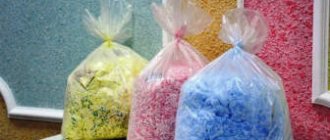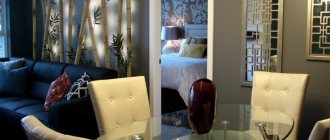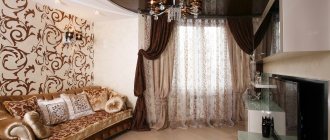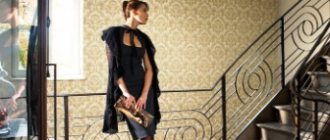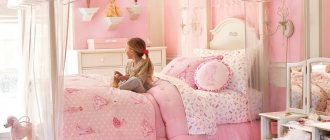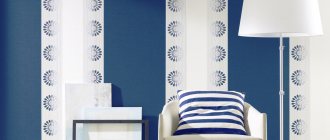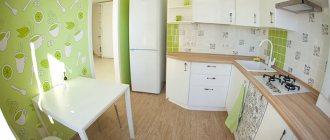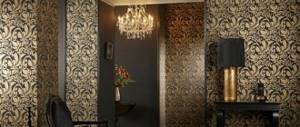Recently, a new type of finishing materials has appeared on the construction market - liquid wallpaper. This is a finishing coating for ceilings and walls, combining the properties of decorative plaster and ordinary roll wallpaper. The practicality and durability of this type of finish have made it very popular in the repair industry. Liquid wallpaper has universal application. They can be used in different rooms, including the kitchen, where the temperature and humidity levels are constantly changing.
This amazing coating can look like wallpaper, look like decorative plaster or imitate stone
What is liquid wallpaper?
In its original form, liquid wallpaper is a dry mixture packaged in bags. Before use, the material is diluted with water, and then the resulting thick and viscous mass is applied to the working surface.
Liquid wallpaper is sold in the form of dry flakes, packaged in bags depending on color
Before use, liquid wallpaper is diluted with water at room temperature.
The finished composition is applied to the wall or ceiling like plaster.
The composition of liquid wallpaper includes:
- cellulose or silk fibers;
- binder (paste, bustylate, wallpaper glue, PVA);
- antiseptics that ensure the finish is resistant to mold and mildew;
- acrylic or latex paints that give the coating any color;
- decorative components (pearl sparkles, marble chips, colored threads, etc.).
Components of liquid wallpaper
Liquid wallpaper can be smooth or textured. In the first case, the coating looks like a flat surface, and in the second, it resembles a soft canvas. However, both types of finishes do not create seams when applied. In addition, they help hide various defects of the working surface (irregularities, depressions, small cracks).
Liquid wallpaper can be used to cover the entire wall or any area.
The technique of applying liquid wallpaper allows you to create various shapes from it
A border is the simplest element that can be made from liquid wallpaper
Using this finishing material, you can create exclusive designs by combining multi-colored mixtures in accordance with fashion trends and your own preferences.
Using liquid wallpaper you can create a truly stylish and memorable room design
Is it possible to use liquid wallpaper in the kitchen?
The walls and ceiling in the kitchen have to be washed frequently, since not only dust, but also grease deposits and soot settle on them. However, liquid wallpaper is not moisture resistant. When exposed to water, they are immediately washed off from the work surface. They can only be cleaned with a dry cloth or special attachments for a vacuum cleaner. Of course, these methods will not help cope with severe pollution. But this does not mean that it is completely impossible to use this finish in the kitchen. Liquid wallpaper in the kitchen can be used around the entire perimeter, except for the cooking area.
It is better to use tile finishing on the kitchen apron
If the finish is coated with acrylic varnish, it will become waterproof. At the same time, the coating will change slightly in color and its texture will become rougher.
An accent wall in the kitchen dining area is the best place for liquid wallpaper
Overall, this material is very convenient for the kitchen. It does not interfere with the access of oxygen to the working surface, which allows you to maintain an optimal level of humidity in the room. After drying, the wallpaper is not afraid of drafts and prolonged exposure to high temperatures, and also does not absorb various odors.
Pasting in the kitchen
Many reviews say that such a solution is inappropriate. The disadvantage is that they are not able to withstand large quantities of moisture, foreign odors and dirt. But this problem can be easily eliminated by using auxiliary processing compounds.
Interesting! Liquid wallpaper is not suitable for gluing the entire kitchen. It is better to use traditional mosaic tiles to protect the work surface.
This type of plaster in the interior, namely this group of materials includes liquid wallpaper, is treated with acrylic varnishes to provide additional protection. Then the wallpaper will not absorb odors. And if necessary, they can be washed; user reviews will confirm this.
But there is no need for additional processing if the material is applied to the wall opposite the working wall. If a fragment is damaged, it will be enough to wet it with a spray bottle and clean it off. Then the damaged area simply changes.
Advantages and disadvantages of using liquid wallpaper in the kitchen
Using this type of finish in kitchen interior design has many advantages:
- The structure of the mixture does not contain harmful substances, so it is completely safe for health and does not cause allergic reactions.
- The material is elastic, which means it can be used to create various arches, ledges and niches.
- Wallpaper does not crack due to natural shrinkage of the walls.
- If the coating is damaged, it is enough to wet the damaged part, remove it from the wall and apply a new mixture to this place.
Restoring a damaged fragment of liquid wallpaper takes literally 5 minutes
- The material has good thermal insulation. Consequently, heat loss in the room will be minimal even in the autumn-winter season.
- The texture of the wallpaper is quite dense, which provides it with good soundproofing properties.
Liquid wallpaper easily hides minor wall imperfections
However, this finishing material also has disadvantages:
- High price.
- Instability to direct sunlight.
- The mixture takes a long time to dry after application to the work surface (up to 10 hours).
Liquid wallpaper is used not only for wall decoration, but also for decorating the ceiling
Stages of performing the work of applying liquid wallpaper
- At the preparatory stage of work, it is necessary to carefully treat the surface to remove any existing contaminants. If necessary, remove previous coatings. Deep potholes and cracks must be plastered.
- If there are metal elements, they must be coated with paint before finishing work begins. This will avoid metal corrosion and rust stains.
- The areas affected by the fungus must be thoroughly treated with an antiseptic. It is prohibited to begin finishing until the surface is completely dry.
- When priming walls, it is recommended to use a waterproofing primer, which will help avoid yellow stains.
- At this stage it is necessary to begin diluting the product. When diluting, it is recommended to add water to the mixture, and not vice versa. The exact amount of water required for dilution is indicated in the instructions. After this, the mixture must be thoroughly mixed, left to swell and mixed again. This procedure will avoid the formation of lumps and help make the mixture homogeneous.
- To perform finishing work you will need: a hard spatula and a hard paint roller. A small part of the finished mixture must be applied to the surface and smoothed thoroughly. The standing thickness is adjusted by the pressure force. The maximum layer thickness should not exceed 3 mm. To obtain a smooth surface, it is advisable to use a spatula. If your goal is to obtain a structured surface, use a roller.
- If you have any diluted unused mixture left, you need to roll it out on film, wait for it to dry completely (3 days), pack it and put it away for storage.
How to choose the right wallpaper
Articles telling about all the nuances of applying liquid wallpaper and preparing walls.
What liquid wallpaper is suitable for the kitchen?
When choosing liquid wallpaper for the kitchen, you should pay attention not only to its visual appeal, but also to practicality. In this case, the decorative finish will be used for at least 10 years, maintaining its original attractiveness throughout its entire service life.
High-quality liquid wallpaper is a fairly durable finishing material
It is better to purchase coatings of non-uniform colors that contain a large number of decorative elements, since on such wallpaper minor dirt (stains, drops of grease, etc.) will not be very noticeable.
The material is expensive, but you can’t skimp on it. German and French companies are considered the best manufacturers, and products from unknown companies should be discarded.
An interesting solution would be to combine liquid wallpaper with other finishing materials (wood, wall panels, tiles, slate stone, gypsum brick, etc.).
You can create a beautiful pattern on the wall from liquid wallpaper using stencils
Kitchen design with liquid wallpaper interior photo
Using liquid wallpaper in the interior of the kitchen, you can get an original design for the room. You can complete the workflow yourself. But, if you want to get a high-quality and complex drawing, we recommend using design services.
Prepare the mixture according to the manufacturer's instructions. Recommendations are indicated on the back of the package.
As we promised, at the end of the article, we present a photo report: the design of liquid wallpaper in the kitchen. Pay attention to the combination of ZhO with facing material and the variety of patterns.
Types of liquid wallpaper
This finish is divided into 3 groups, differing from each other in composition and performance properties.
Cellulose wallpaper
The main component of this material is wood fibers. It differs from its analogues in its affordable price, retains heat well in rooms, and masks minor defects on the walls and ceiling. However, this finish quickly fades in the sun, so it is recommended to use it not in the kitchen, but in other areas of the apartment protected from ultraviolet radiation (for example, in the hallway).
The durability of cellulose wallpaper is at the initial level, but anyone can afford such material, because its price is an order of magnitude lower
Silk wallpaper
The covering is made from threads of artificial or natural silk, as a result of which it has a pronounced satin shine and velvety feel. The material is much more expensive than other types of finishes, but the high price is due to its excellent performance characteristics. Wallpaper is durable, has increased strength and does not change color under the influence of bright sunlight. Hence, they are ideal for use in kitchen areas.
Liquid wallpaper based on silk fibers is resistant to ultraviolet radiation
Silk-cellulose wallpaper
The mixture is made from crushed wood, but colored chopped silk fibers are added to it. Silk threads here perform only a decorative function, giving the wallpaper a characteristic shine and texture. It is cellulose that provides the performance characteristics, so the coating is suitable only for rooms with low operational load.
Silk-cellulose wallpaper - a reasonable compromise between price and quality
Features of choosing liquid wallpaper in accordance with kitchen design
Plain, smooth coverings are suitable for kitchens decorated in a classic style. For small rooms, the ideal option would be silk wallpaper in beige, light blue and peach tones.
An example of decorating a wall with liquid wallpaper, the color of which is in harmony with the decorative decoration of the ceiling in a classic kitchen
From materials of different colors you can create a unique original design on the wall
Gray models look good in styles such as loft and Provence. For a boho design, you need to choose bright coatings with a velvety texture.
Bright interior of the kitchen dining area in boho style with plain wall decoration with liquid wallpaper
This type of wall decoration would be appropriate in a kitchen in a minimalist style.
To zone the space in a spacious kitchen, you can use liquid wallpaper of different colors. The main thing is that all the shades used are harmoniously combined with each other.
An original composition of multi-colored liquid wallpaper, made by the hands of the owner of the house
Most liquid wallpaper in the kitchen, photos of which are presented on the Internet, are designed in light colors: gold, pink, green, white, but rich colors (purple, blue, orange) will also be a stylish solution for this room.
Kitchen in a modern style with light-colored liquid wallpaper
Liquid wallpaper is an excellent way to decorate the walls and ceiling in the kitchen. A wide range of shades and fillers of this material allows you to make the interior of the room completely unique. By combining dry mixtures with each other, you can create excellent compositions, and seams will not form on the work surfaces, worsening the appearance of the coating.
About the varieties of liquid wallpaper
This is a very interesting and varied coating, not only in color, but also in possible texture. The quality and durability of liquid wallpaper in the kitchen directly depend on the base used.
There is, for example, a type made from natural silk fibers. They create a very unusual pattern on the work surface. This is one of the strongest and most durable types. The material is resistant to fading and abrasion. Paper wallpapers are much cheaper, but they are also seriously inferior in quality. The ability to easily carry out restoration is one of the main advantages. What is clearly visible in the photo:
Cotton is considered one of the most environmentally friendly materials on the market. But it is cotton that is most susceptible to abrasion.
One of the most common varieties is silk-cellulose. They are resistant to abrasion and any type of mechanical impact. But they are cheaper than those made of 100 percent silk. The threads serve not only as a decorative element, but also as a connecting link in the entire structure. The material is durable, because silk fibers are difficult to tear.
Options for applying liquid wallpaper - the experience of the masters is presented in the video below:
Recommended Posts
What can be made from old wallpaper
How to make liquid wallpaper at home
Liquid wallpaper Silk plaster
Liquid wallpaper: application technology
Do-it-yourself liquid wallpaper: from newspapers, old wallpaper, sawdust, uh...
Liquid wallpaper: consumption of one package
